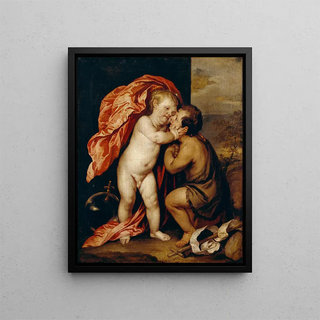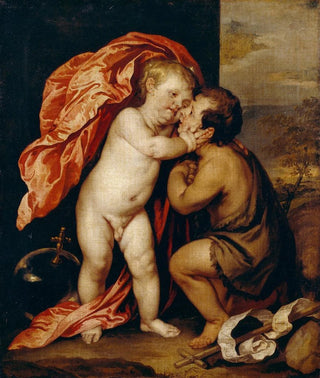Art print | The Children of Jesus and Saint John the Baptist - Antoine van Dyck


View from behind

Frame (optional)
In the world of art, certain works transcend time and space, captivating the imagination of viewers across centuries. "Les Enfants Jésus et Saint Jean-Baptiste" by Antoine van Dyck is a striking example. This painting, emblematic of Flemish Baroque, evokes tenderness and innocence that touch the soul deeply. Through this art print, the viewer is invited to immerse themselves in a universe where spirituality meets the purity of childhood, revealing the subtlety of an era when painting was a means of expressing faith and human emotion.
Style and uniqueness of the artwork
Van Dyck's style is distinguished by his ability to capture not only the physical features of his subjects but also their spiritual essence. In "Les Enfants Jésus et Saint Jean-Baptiste," the faces of the two children are imbued with an almost angelic sweetness. The light, skillfully orchestrated, gently illuminates their features, creating a subtle contrast between shadows and highlights. The drapery of the garments, richly textured, testifies to the technical mastery of the artist, while the composition, balanced and harmonious, guides the viewer's gaze through the piece. Every detail, from the innocent gaze of the Child Jesus to the protective attitude of Saint John the Baptist, is carefully considered, revealing an emotional depth that invites contemplation.
The artist and his influence
Antoine van Dyck, a pupil of Rubens, established himself as one of the greatest masters of his time. His influence on portraiture and religious painting is undeniable. Settling in London, he also left his mark on the English court, becoming the official painter of Charles I. His unique style, blending elegance and sensitivity, has inspired many artists through the ages. Through his work, van Dyck was able to give voice to human emotions, transforming painting into a universal means of communication. "Les Enfants Jésus et Saint Jean-Baptiste" perfectly illustrates this ability to evoke deep feelings while remaining rooted in a religious tradition. Thus, van Dyck's legacy endures.

Matte finish

View from behind

Frame (optional)
In the world of art, certain works transcend time and space, captivating the imagination of viewers across centuries. "Les Enfants Jésus et Saint Jean-Baptiste" by Antoine van Dyck is a striking example. This painting, emblematic of Flemish Baroque, evokes tenderness and innocence that touch the soul deeply. Through this art print, the viewer is invited to immerse themselves in a universe where spirituality meets the purity of childhood, revealing the subtlety of an era when painting was a means of expressing faith and human emotion.
Style and uniqueness of the artwork
Van Dyck's style is distinguished by his ability to capture not only the physical features of his subjects but also their spiritual essence. In "Les Enfants Jésus et Saint Jean-Baptiste," the faces of the two children are imbued with an almost angelic sweetness. The light, skillfully orchestrated, gently illuminates their features, creating a subtle contrast between shadows and highlights. The drapery of the garments, richly textured, testifies to the technical mastery of the artist, while the composition, balanced and harmonious, guides the viewer's gaze through the piece. Every detail, from the innocent gaze of the Child Jesus to the protective attitude of Saint John the Baptist, is carefully considered, revealing an emotional depth that invites contemplation.
The artist and his influence
Antoine van Dyck, a pupil of Rubens, established himself as one of the greatest masters of his time. His influence on portraiture and religious painting is undeniable. Settling in London, he also left his mark on the English court, becoming the official painter of Charles I. His unique style, blending elegance and sensitivity, has inspired many artists through the ages. Through his work, van Dyck was able to give voice to human emotions, transforming painting into a universal means of communication. "Les Enfants Jésus et Saint Jean-Baptiste" perfectly illustrates this ability to evoke deep feelings while remaining rooted in a religious tradition. Thus, van Dyck's legacy endures.






